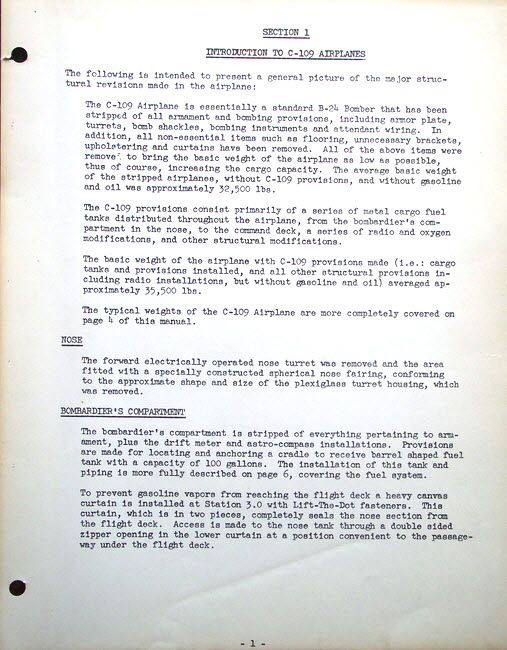
|
|
 |
Many thanks to Paul Stahl Jr, for sending us this modification manual for the C-109 fuel transport, an modified verison of the B-24 bomber. His father, Paul Stahl Sr, was the project engineer for the C-109.
TEXT
Page 1 - Section 1 - Introduction to C-109 Airplanes
SECTION 1
INTRODUCTION TO C-109 AIRPLANE
The following is intended to present a general picture of the major structural revisions made in the airplane:
The C-109 Airplane is essentially a standard B-24 Bomber that has been stripped of all armament and bombing provisions, including armor plate, turrets, bomb shackles, bombing instruments and attendant wiring. In addition, all non-essential items such as flooring, unnecessary brackets, upholstering and curtains have been removed. All of the above items were removed to bring the basic weight of the airplane as low as possible, thus of course, increasing the cargo capacity. The averagae basic weight of the stripped airplanes, without C-109 provisions, and without gasoline and oil was approximately 32,500lb
The C-109 provisions consist primarily of a series of metal cargoe fuel tanks distributed throughout the airplane, from the bombardier's compartment in the nose, to the command deck, a series of radio and oxygen modifications, and other structural modifications.
The basic weight of the airplane with C-109 provisions made (i.e.: cargo tanks and provisions installed, and all other structural provisions including radio installations, but without gasoline and oil) averaged approximately 35,500lb.
The typical weights of the C-109 Airplane are more completely covered on page 4 of this manual.
NOSE
The forward electrically operated nose turret was removed and the area fitted with a specially constructed spherical nose fairing, conforming to the approximate shape and size of the plexigrlass turret housing, which was removed.
BOMBARDIER'S COMPARTMENT
The bombardier's compartment is stripped of everything pertaining to armament, plus the drift meter and astro-compass installations. Provisions are made for locating and anchoring a cradle to receive barrel shaped fuel tank with a capacity of 100 gallons. The installation of this tank and piping is more fully described on page 6, covering the fuel system.
To prevent gasoline vapors from reaching the flight deck a heavy canvas curtain is installed at Station 3.0 with Lift-The-Dot fasteners. This curtain, which is in two pieces, completely seals the nose section from the flight deck. Access is made to the nose tank through a double sided zipper opening in the lower curtain at a position convenient to the passage-way under the flight deck.